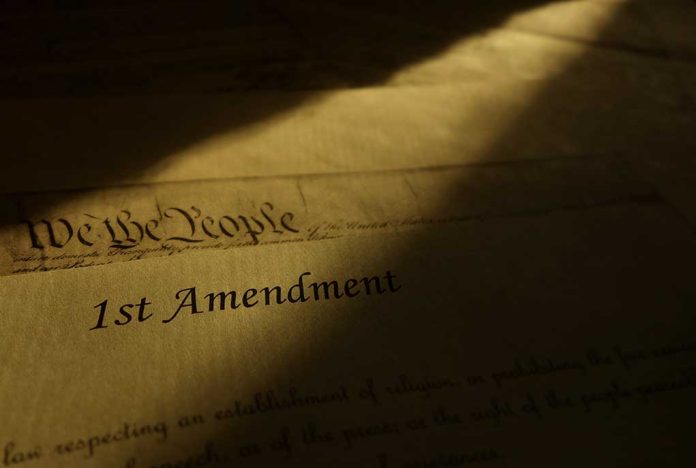
Back in 2022, President Donald J. Trump unveiled a bold policy initiative aimed at what he considers dismantling censorship and restoring free speech in America. The policy plan has made its way back into the spotlight following his projected victory in the 2024 election.
At a Glance
- Trump announced a comprehensive plan to protect and strengthen First Amendment rights two years ago.
- The initiative targets alleged collusion between government agencies, tech companies, and media.
- Proposed measures include executive orders, legal actions, and revisions to existing laws.
- Trump frames the free speech fight as crucial for America’s survival and Western society.
Trump’s Vision for Free Speech
In a decisive move to address what he perceives as a threat to American liberty, former President Donald J. Trump announced a sweeping free speech policy initiative in 2022. The plan, detailed on his official website, outlines a series of actions aimed at reinforcing First Amendment protections and countering what Trump describes as an “unholy alliance” of entities working to silence American voices.
Trump’s initiative is rooted in the belief that free speech is under siege in the United States. He argues that a coalition of “Deep State bureaucrats, Silicon Valley tech giants, left-wing activists, and depraved corporate news media” has conspired to censor and manipulate public discourse. The former president’s plan seeks to dismantle this alleged censorship regime and restore what he sees as the fundamental right to free expression.
While Trump announced this initiative nearly two years ago, the plan resurfaced thanks to a recent social media post by Elon Musk. Trump’s projected victory in the 2024 election has revived discussions about his plans and campaign promises across the U.S.
This alone puts DJT in company with the greatest U.S. presidents since Lincoln. The globalist project has laid siege to democracy and freedom across the globe. The USA is the final redoubt. President Trump just launched freedom’s counterattack. https://t.co/2brXEjTByg
— Robert F. Kennedy Jr (@RobertKennedyJr) November 9, 2024
Key Components of the Initiative
The proposed policy encompasses a wide range of measures designed to protect free speech across various platforms and institutions. Among the most significant proposals are:
1. An executive order to prevent federal agencies from colluding with others to censor lawful speech. This aims to address concerns about government overreach in content moderation.
2. A ban on using federal funds to label domestic speech as misinformation or disinformation. This measure seeks to prevent the alleged weaponization of government resources against protected speech.
3. The identification and firing of federal bureaucrats engaged in censorship activities. Trump pledges to hold government employees accountable for actions that may infringe on free speech rights.
4. Directing the Department of Justice to investigate and prosecute parties involved in online censorship. This suggests a more aggressive legal approach to defending free speech in the digital realm.
Reforming Digital Platforms and Section 230
A significant portion of Trump’s initiative focuses on reforming how digital platforms operate and are regulated. He proposes revising Section 230 of the Communications Decency Act to ensure that tech companies meet standards of viewpoint neutrality, transparency, and adherence to the First Amendment if they wish to retain their liability protections.
The plan also calls for breaking up what Trump terms the “censorship industry” by halting federal funding to non-profit organizations and academic programs involved in content moderation efforts. This move aims to reduce the influence of entities that Trump believes are working to suppress certain viewpoints.
Protecting User Rights and Data
The initiative includes proposals aimed at protecting user rights and data. Trump suggests implementing a seven-year cooling-off period for former intelligence officials before they can join Big Tech companies with access to large amounts of U.S. user data. This measure is designed to prevent potential conflicts of interest and protect user privacy.
Additionally, Trump proposes a Digital Bill of Rights that would include digital due process, banning surveillance and data collection without users’ consent, and establishing rights regarding online account suspension and content moderation.
A Call to Action
Trump frames his free speech initiative as more than just a policy proposal; he presents it as a crucial battle for the future of America and Western society. The former president’s rhetoric underscores the perceived urgency and importance of this issue to his base and potential voters.
Trump’s free speech initiative represents a direct challenge to current practices in digital communication and government oversight, promising a significant overhaul of the status quo if implemented. The proposal has sparked debate among supporters and critics alike, highlighting the complex and contentious nature of free speech issues in the digital age.














